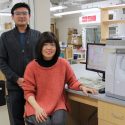Genomics portends next revolution in agriculture
Depending on your point of view, the great promise or peril of modern agriculture has germinated on millions of acres of North American cropland as the genetically modified organism — or GMO — has taken center stage.
But as science begins to accumulate and explore plant and animal genomes – the entire set of genetic instructions for a particular organism – a new revolution is in the offing and, according to university biologist Robert Goodman, promises a long-lasting and favorable impact on agriculture worldwide.
Addressing scientists here today, Feb. 18, at the annual meeting of the American Association for the Advancement of Science, Goodman forecasts a world of change as scientists use the maps of the genomes of key plants and animals, giving them unprecedented access to the genetic instructions that govern life. The new knowledge, he says, could significantly enhance the traditional and far-less controversial practices of crop and livestock improvement through breeding.
“From a scientific perspective, the public argument about genetically-modified organisms, I think, will soon be a thing of the past,” Goodman says. “The science has moved on and we’re now in the genomics era.”
Instead of slipping one or two genes in or out of an organism to confer or promote a desirable trait in a plant or animal, as is the case in GMO technology, the advent of genomics portends an even more powerful tool as scientists can now rapidly comb the thousands of genes in a genome to see which genes are at work.
“The key is you can detect function.” says Goodman. “You can see genes at work and you can focus on lots of genes all at once. This is what breeders have done for more than a century, but with new knowledge and modern tools of the trade, breeders can make more rapid progress on many more traits than in the past.”
The potential of genomics to do good, especially in developing countries, is enormous, Goodman argues. And he expresses hope that the polarizing issues and mistakes that have dogged GMO technology can be avoided.
“Genomics adds centrally and substantially to the toolbox of the plant breeder,” says Goodman, a professor of plant pathology and a former executive vice president for research and development at Calgene, a pioneering crop biotechnology company.
Critically, the technology can be a path to world food security and aid in the development of industries and institutions in countries that will permit them to cope with rapidly growing populations and dwindling resources, Goodman says.
“Researchers in public institutions in developing countries need this technology,” he argues, “and, more to the point, they themselves can use it – if arrangements are put in place to make useful genomic sequences and technologies generally available.”
Goodman serves as an advisor to the McKnight Foundation, an organization that promotes scientific advancement for crop improvement in many of the world’s less developed countries.
He cited the fact that the rice genome, now completely mapped, has the potential to spark significant increases in production and begin to eliminate some of the human health and environmental problems associated with industrial agriculture. For example, by building resistance to insect pests into crops, scientists may help curb cavalier use of chemical pesticides that now take a huge environmental and human health toll in the developing world.
The power of genomics, explains Goodman, lies in the fact that nature has been parsimonious in its use of genes. For example, rice, a member of the grass family, has a genome with few fundamental genetic differences from other grasses such as corn, wheat, and tef, a grain on which millions of people in Africa depend. The genome for A. rabidopsis, a common laboratory workhorse for plant scientists, is now in hand and provides a framework for using genomics in many crops such as legumes, vegetables and fruits.
The ability now to employ genomic technology to comb these genetic instructions and focus on new combinations of genes based on their functions and interactions means that the pace of development of new plant cultivars, many of them not engineered in the way GMOs are created, may accelerate dramatically.
Goodman says it is essential to get the technology into the hands of scientists in developing nations because they will have the best opportunities to tailor the technology to local agricultural conditions, crops, crop improvement priorities and traditions.
Although an advocate of employing genomic technology, Goodman parts company with many in industry by advocating labeling of engineered products and greater public dialogue and education. There is also great danger, he warns, in a potential concentration of power by having the technology held by just a few transnational companies.
“The controversy is as much about the economics of the system as it is about the technology or its safety,” he says. “The industrialized model of agriculture that we depend on won’t work very well in the world at large where nearly half of the population is engaged in food production. We need new models, but we can’t shut the door on a technology that has tremendous potential to improve the lives of so many.”
Tags: biosciences, research



